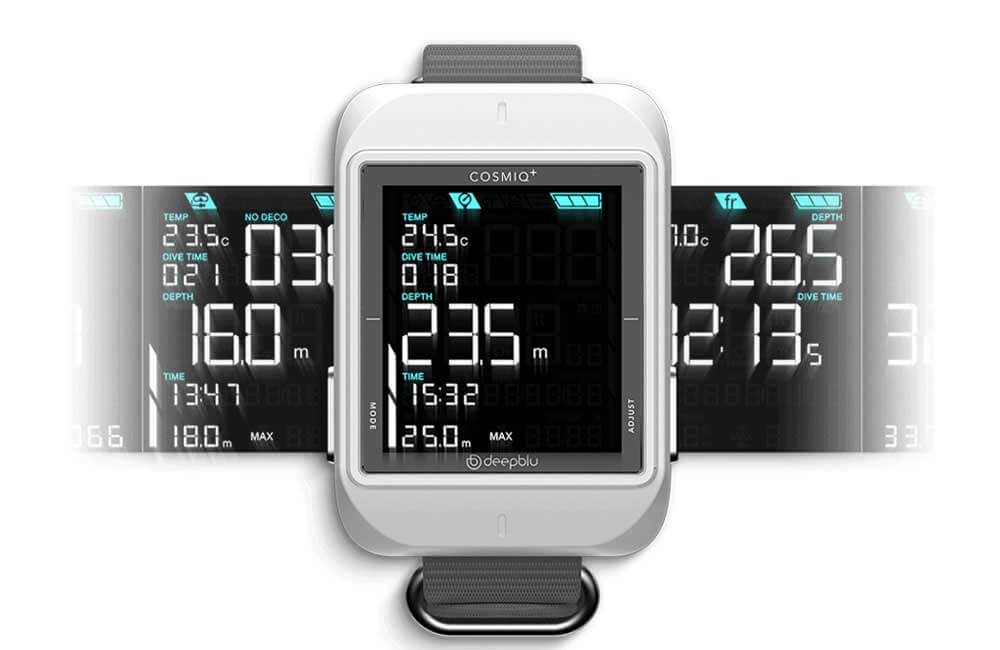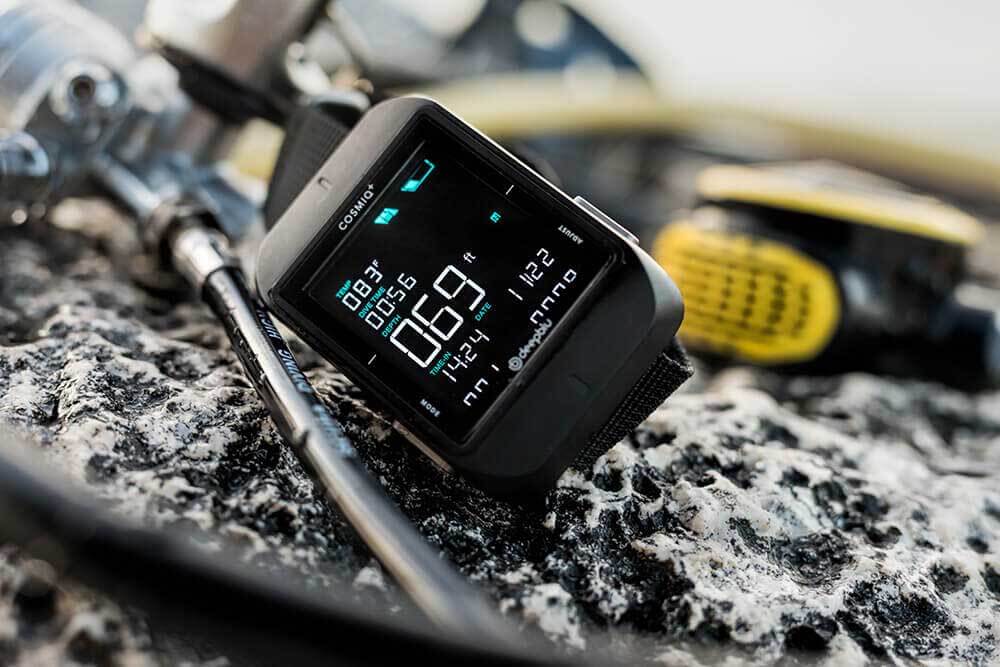
By Max James
More often than not, when it comes to technology, simple is best. The elegant, functional, and extremely easy-to-use Deepblu Cosmiq+ dive computer surely proves the point.
If you have no ambitions to use complex mixed gases, nor do you plan to push the limits with multiple-stop decompression dives, then this is the computer for you. And, let’s face it that covers a large number of sport divers.
As the iPhone has shown, you can go a long way with providing customers with what they want and need in a well-designed and attractive package. Also, just as Apple’s remarkable success indicates, you can often persuade them to pay a premium for services and functions people hadn’t even realised they desired.
This really is the dive computer for the iPhone generation.
What you get

It is neatly packaged in a useful travel case, comes with two nylon wrist straps, a magnetic USB charger and a basic get-going leaflet. There are currently five different colour configurations.
While it is wrist-mounted and could pass as a natty smartwatch, it is not meant to be used as a watch nor to be worn except when diving or free-diving. In fact, it recommended not to switch it on during air travel as it will assume you are on a dive during the plane’s descent.
It is powered by a built-in li-ion battery which you cannot replace. The manufacturers say its performance will be sustained for at least 500 charges before the 7-12 hours of use per charge depending on brightness settings may decline. The obvious advantage of a closed unit is that it is one less thing that can go wrong – no O-ring failures flooding your computer while changing batteries.
The charging cable locates with a grooved plastic head on the back of the case and a satisfying magnetic clunk as it connects. However, be careful when charging as I found it was quite easy to dislodge if the unit or the power source is moved. It was most stable with the computer face down, and you can easily see if the connector is correctly in place.

There are two relatively large push-buttons on each side of the unit which move you through the basic modes available: Watch, the default which shows time and battery level; Scuba, the diving interface; Bottom Timer, depth gauge and timer only; Freediver, depth, dive time and various alarms; Log, previous 25 dives and Sync, for connecting to the Deepblu app.
On activation, the major difference with other diving computers becomes apparent. For this is the first diving computer where you can quickly adjust the setting for the various modes not by clicking through layered menus on the unit but by an easy-to-scroll-through app on your smartphone using a Bluetooth connection.
As I said, this is the dive computer for the smartphone generation. While this might seem to some Luddites as a further irritating invasion of the phone into every aspect of their lives, it is, in fact, a remarkably efficient and quick way to adjust your settings.
Altering your nitrox mix takes seconds, unlike many computers I have used in the past.
The first scroll-down menu allows you to adjust general settings such as units of measurement and backlight brightness. The Scuba menu lets you pick one of three settings for the decompression algorithm – conservative, normal or progressive. The basic algorithm is the Bülhmann ZHL-16C. However, there is little or no guidance as to the impact of the settings on your dive.

I used the conservative mode during an intensive, four-dives a day, liveaboard trip far from a chamber and there were significant differences with my usual computer, particularly at depths over 25m with up to five minutes being trimmed off no-decompression dive times. Probably, no bad thing in the circumstances. In normal mode there were only marginal variations with my control computer.
The app also allows you to alter your PPO2 setting from 1.2 to 1.6, your nitrox mix from 21% to 40% and to set depth and time alarms. The audible alarms are not the loudest I have ever heard – in fact, I struggled to hear them. Personally, something I welcome as I find the constant beeps and buzzes of some computers a pain and the visual alarm displays of the Cosmiq+ are clear and easy to understand, and they should be what we are diving to rather than relying on audible prompts.
Another minor niggle is the stripped back options offered in the app are quite limited. For example, there is no way to alter the duration of safety stops. The house suggestion for safety stops on the liveaboard I was on, was for five minutes at five metres rather than the standard three minutes. However, as the screen is so clear, it was no problem to add a further two minutes using the dive time read-out when your three-minutes was completed on the safety stop count down.
You can use the side buttons on the unit to adjust your nitrox mix when in Scuba mode if you wish and you can change depths and alarms when in Freediving mode using the same method. However, the ease of use of the app makes this more of a backup than a regularly used option.
Underwater

A neat feature is that you can set the default mode in the app to either Scuba, Bottom Timer or Free so when you get beneath a metre or so the unit automatically switches to the correct mode – no fiddling about as you descend because you left the unit on Synch between dives.
I found the tough, nylon, wrist-strap perfectly serviceable. It uses a ‘NATO’ double threading style method of attachment which seemed a bit overkill as you would have to destroy the unit’s plastic case to detach it from the strap. Pulled tight, I rarely felt the Cosmiq+ slipping down my wetsuited arm. On the few occasions it did (when I had failed to pull it tight), it was easy to push the computer further up your arm to keep it secure. It has an extremely low profile and doesn’t get tangled even when putting on or taking off your BCD.
The Cosmiq+ has one of the easiest to read faces of any small, wrist-mounted computer I have used – better than many with far larger, bulkier screen. Even the smallest legends, such as water temperature are legible, and the information displayed on the rectangular face (4.5cm x 5cm) is well organised in a coherent hierarchy. Your depth and no-deco times are the largest numbers on the screen.

On no-deco diving, all was a breeze. However, checking out what happens if you slip over is a bit more confusing. The Cosmiq+ very clearly flashes Ceiling, alerting you that you now have to make a stop, but working out the display at that point was it bit more taxing than I would have liked. First, it displays your recommended stop time as both minutes and seconds, which seemed unnecessary, and it took me a while to decipher. While it clearly shows your ceiling depth, it doesn’t give you a total ascent time. Once you work out what it is telling you, it does effectively take you through the process. However, this is not the dive computer for planned and regular decompression diving. Instead, it is an extremely easy-to-use one, ideal for dealing with those times when you are distracted or forced to slip into decompression by circumstances beyond your control.
But to be fair, that covers an awful lot of the diving that goes on in the world. Most holiday divers stay inside their no-deco limits, and a computer that is easy to set and even easier to read is probably safer and more appropriate than having to wade through complex menus and unintelligible displays more suited to mission control than pottering around a coral reef.
The adjustable backlit display of the DeepBlu Cosmiq+ dive computer is a big plus. It is permanently on, a boon for night dives (no more shining your torch on your wrist at just the right angle) and in bright sunshine, you can easily cup your hand around the screen to see the display.
The app

Central to using the Cosmiq+ is the Deepblu app which is well designed and packed with functionality. Not only does it allow you to alter a range of settings for the computer, it also connects you to a rich social media world where your photos and logs can be shared (this is optional for those who wish for some diving privacy), a growing range of user-generated content, some curated content and very usable digital logbook.
The computer itself only holds 25 separate dives in its logbook so it is assumed you will be downloading to the app at regular intervals. Uploading a dive is helped by the ever-growing amount of data supplied by other divers – the most obscure dive sites are readily accessible and you can input a wide range of pre-set options such as type and nature of the dive plus your more personal notes and photos. It is a doddle to quickly build-up a detailed personal history of your diving and, if you wish, share your adventures with the world. You can link to selected buddies and send messages.
The app also keeps you in touch with the free firmware updates Deepblu releases.

Conclusion
There are cheaper basic dive computers on the market which offer all the functionality the Cosmiq+ offers underwater, but none which combine the simplicity of use, an excellent backlit screen and the quality and fun of a first-class app with logbook and social media. If you are looking for a good dive computer to use for no-decompression diving on your travels plus a first-rate digital logbook and handy social media built-in then this should be top of your list. Highly recommended.
Specifications
Water resistance: 100m (330ft) • Fresh or highly saline waters • Gases: air & nitrox (21% to 40%) • PPO2: 1.2 bar to 1.6 bar • Altitude: Above 3,000m (1,00ft) • Battery: rechargeable lithium-ion • Data transfer: Bluetooth 4.0
RRP US $399
Check it out on Amazon
To find out more or order, visit bit.ly/cosmiq-ukdive


